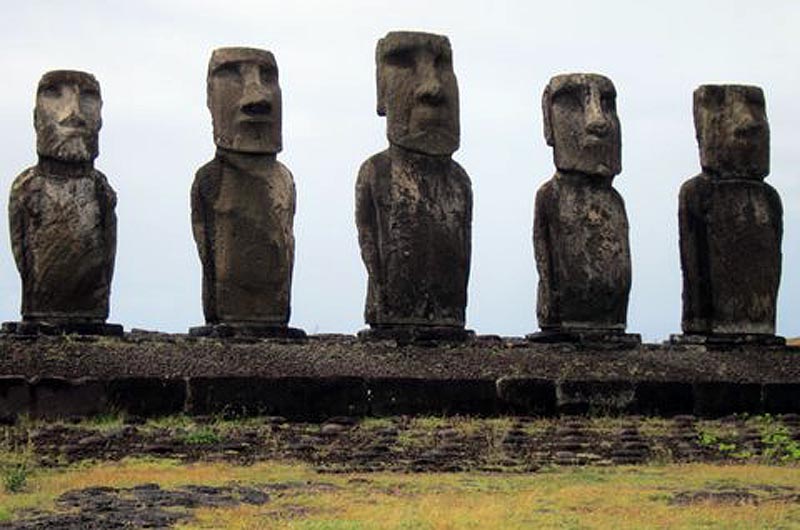Summer is around the corner and is an extremely busy time for birds and humans alike. Spring migration is pretty much finished and our resident birds are busy building nests, laying eggs and tending to the business of raising a new generation. People are opening and cleaning houses for renting and organizing, and stocking and preparing seasonal businesses for the summer months. Gardens are being planted and hay is being cut. I have received very little bird news and none of it is new. So before I forget, I will tell you about our trip to an island in the Pacific Ocean that is the shape, and almost the same size, as the Vineyard.
Easter Island is known by the Rapa Nui (Easter Island natives) as the navel of the world. A speck of land in the middle of nowhere is the presumed reason for the moniker. Four Vineyarders: Paul Magid, Anita Botti, Flip Harrington and I boarded a plane at 8:30 a.m. on March 15 in Santiago, Chile. Four and a half hours later and 2,000 miles from mainland Chile, we landed in Hanga Roa, the only town on Easter Island. We were in the South Pacific, but unlike any other Polynesian Island, the residents speak Spanish. Chile considers Easter Island part of its country. Spanish is the lingua franca; the language originally spoken on Easter Island was Rapanui, which is similar to Tahitian.
Easter Island is said to have been colonized by Polynesians around 700 AD and was called Rapa Nui. Dutch explorer Jacob Roggeveen was the first outsider to find Rapa Nui. He landed there by chance on Easter Sunday, thus the Easter Island name. Rapa Nui’s population boomed and eventually busted, so that in 1877 here were only 111 Rapa Nui residents. Luckily their culture and language was saved and many Rapa Nui children and adults today are learning to speak the native language as well as Spanish.
During the population boom, giant heads known as Moai were carved from volcanic stone. Why these Moai were carved and moved to certain areas on Easter Island is still a mystery, although there are many theories. The one most people agree on is that the heads represented the soul of an ancestor and were set in specific areas to defend the land of that family.
Another mystery surrounding these heads is that many of them have been tipped over, and the quarry where the materials were mined had tools dropped in place as if something tragic had distracted the craftsmen. Again theories abound, but the consensus is that Rapa Nui became over populated, used up its natural resources, and families fought for food and shelter nearly doing themselves in.
The Moai and Rapa Nui culture was fascinating, but birds . . . what about them? Many people consider Easter Island a bust for birders as most of the resident birds were introduced from mainland Chile. However, our guide Alvaro Jaramillo had been involved in surveying several islets just off of Rapa Nui and had discovered six species of petrels, as well as red and white-tailed tropicbirds, masked booby, grey and brown noddies and Christmas shearwaters. But let’s back up.
A period in the history of the Rapa Nui people is important to the discovery of the sea birds by Alvaro and others. Rapa Nui was known as the Land of the Cult of the Bird People. Each spring sea birds (probably either great frigatebirds or sooty terns) would return to the offshore islets known as Motus. Young Rapa Nui men would climb down a steep cliff, swim to the Motus and fetch a newly laid egg by the seabird and try to return to the main island with an unbroken egg. A priest of each community would choose a representative and if that young man returned with a whole egg, the priest would be the ruler of the island for a year. This would be akin to climbing down the Gay Head Cliffs, swimming to Nomans Land, getting a herring gull egg and swimming back with it, and climbing back up the Cliffs without breaking the egg.
We went by boat around the mainland side of the Motus and were thrilled to see Phoenix, Kermadec, Herald and Henderson petrels, masked boobies, great frigatebird and brown noddy! Unfortunately we didn’t go the second day to the Motus, where one of the other birders spotted a grey noddy, also known as a grey ternlet.
One aside, Anita Botti is not an avid birder; however, she found the Chilean tinamou, which is a game bird that was introduced to Easter Island from mainland Chile about 100 years ago. We all had missed the tinamou on the mainland. Thanks, Anita!
The Vineyarders could see that Easter Island is on track to have problems similar to those we have had on our Island. We suggested that Josie Nahoe Mulloy, who is part Rap Nui and part Irish and was our guide and the granddaughter of William Mulloy — the archaeologist who restored some of Easter Island most important sites — come visit the Vineyard and the Martha’s Vineyard Commission for comparison and advice.
Please report your bird sightings to birds@mvgazette.com.
Susan B. Whiting is the coauthor of Vineyard Birds and Vineyard Birds II. Her website is vineyardbirds2.com.





Comments (1)
Comments
Comment policy »